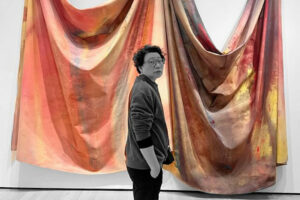IN A fashion show last year at Malacañang’s Goldenberg Mansion, designer Avel Bacudio showed off clothes with indigenous weaves, their use and the discussion around it fashionable today due to discussions on heritage. In a clever move, Mr. Bacudio combined that and the issue of sustainability by making them out of agricultural scrap: fibers were extracted and made into yarns and threads from banana trunks and pineapple crowns from plantations, as well as water lilies.
Mr. Bacudio told these stories to students from iAcademy on May 31, as the second of a series of talks called iAcademy: Insights from Fashion Innovators. The first was a talk by designer Puey Quinones on May 22 called Creative Leadership: Defining and Redefining Your Designer Brand, while Mr. Bacudio’s talk was on Heritage and Advocacy.
Mr. Bacudio discussed his innovations in textiles, made with a collaboration with the DoST-PTRI (Department of Science and Technology – Philippine Textile Research Institute). After taking up a short course in Clothing Technology at the Fashion Institute of Technology last year, Mr. Bacudio approached the institution. Together, they worked at making fabrics from saluyot (jute mallow; a rather sticky vegetable), and water lilies, owing to Mr. Bacudio’s own origins from Lake Buhi in Camarines Sur.
In another project, they also made fabric from pineapple crowns (pineapples for culinary use; not the ornamental pineapples from which the luxury indigenous fabric called piña is sourced) and banana trunks, basically agricultural waste — especially since these by-products cause floods by clogging up waterways when discarded after harvest.
While Mr. Bacudio is happy with the collaboration, there are still many gaps in the project: for example, the raw materials have to be sent to Japan for processing. This is because the machines that the PTRI could be using to process these on their own are quite outdated, Mr. Bacudio saying the date back to the 1960s. These make clothes with smaller thread counts and less refined results.
“We need government support talaga,” he told BusinessWorld in an interview. He’s pleased with the textiles: he describes them as feeling like cotton, while banana fibers can even be used for suiting (unfortunately, he did not have samples on hand, though he said he’d send some over to iAcademy for the fashion students to study).
A part of the problem also is the question of economics of scale: raw materials are abundant, but the process of making them into something useful takes time and yields small volumes (their scarcity leading to their higher prices).
He also notes that because a lot of our native textiles are made from organic materials, there’s a problem in their maintenance and care — thanks however to innovations from his partnership with the PTRI, they’ve compromised by blending them with other fibers and processing them so they can be more durable (and to much relief, washable).
In the future, he plans to build a store where people can buy the fabrics (as pointed out by a student during a Q&A session, not everybody can travel around the Philippines to source fabric).
He extends the advocacy to helping out native weavers, from whom he sources his materials. “Huwag natin silang tawaran (let’s not haggle with them),” he urged the students during his talk. During a sourcing trip to Zamboanga for some Yakan fabric, for example, he said that they charged P3,500 for a yard of cloth — which is cheap if one considers that it took a whole month to make. “If they won’t weave, they won’t live,” he said in a mixture of English and Filipino.
Another project of his took him to Lumban, Laguna, known for their barong embroidery. To his dismay, he found that only a small number of makers still employ hand embroidery, others mostly relying on machines to do the work. Well and good, except it represents the loss of a cultural skill. To that end, he assembled a group of out-of-school youths so they could study how to embroider by hand.
“Ang gusto lang po nila ay kumain ng tatlong beses sa isang araw (all they want is to be able to eat three times a day),” he said.
“Ginagawa ko ito kasi may mga taong naghihirap (I do this because there are people who suffer),” he said. “Ang pagiging isang fashion designer ay hindi lang gumawa ng damit. Dapat, gumagawa tayo ng damit, pero meron tayong nasa puso (Being a fashion designer doesn’t mean we just make clothes. We should make clothes, but there should be something in our hearts).” — Joseph L. Garcia






